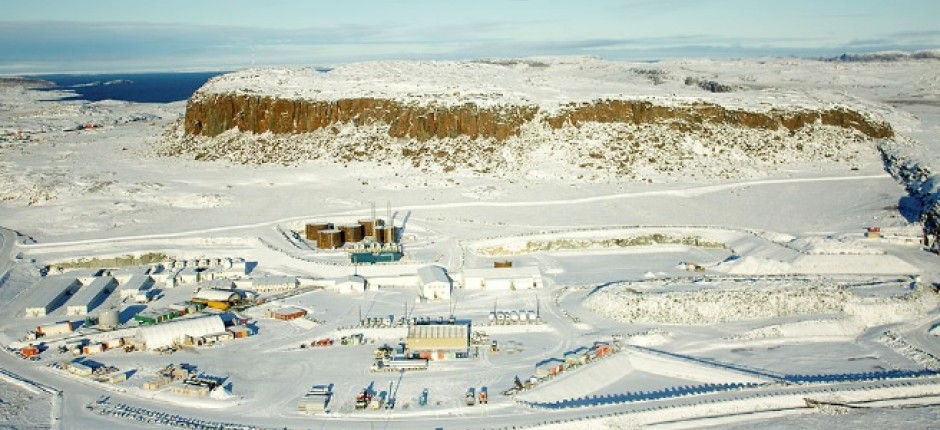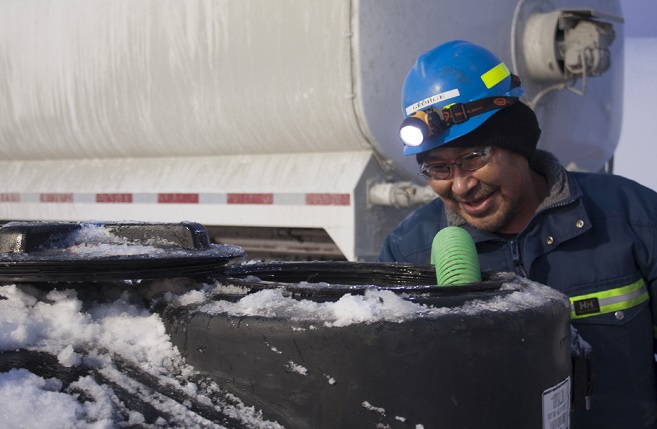By Ashleigh Gaul
Cambridge Bay, Nunavut
While I was in Cambridge Bay reporting for my Greg Clark award, one of my sources told me, “When I’m in Yellowknife and Alberta, I use an imprecise method for quickly gauging the economy. I look down the street from my hotel and count the numbers of big vehicles. It’s an indicator of how much economic activity is directed to those areas.” My source was David Omilgoitok, president and CEO of the Kitikmeot Corporation, an Inuit-run corporation that owns many companies that contract services out to future mines.
Looking down the street from my hotel room in the centre of the hamlet that night, I found indicators of a shifting source of income: many yards stacked with Ski-doos and quads – hunting gear – in all states of repair, and just as often, the shining F-150 tucked neatly into a gravel driveway.
A street over, I saw a new hamlet office being built for the local administrators of the land claim, and a short drive away, on a beach just outside of town, a Central High Arctic Research Station is being built to study Arctic sovereignty, Northern governance and resource development.
It’s all there for one thing – mining.
“I learned that without the training or education to learn skilled trades or administrative skills, local aboriginal workers cannot work themselves into essential positions at the mine.”
When I started researching mining in Nunavut, I came across a lot of strong claims about what it would do for the Arctic. Mining companies touring communities close to potential mine sites claimed the income and royalties from operations could pull the territory out of poverty and save Inuit culture by making hunting gear more affordable. Commentators refer to the coming “Arctic boom” as if it’s a steadily-progressing, and assured, event.
The Greg Clark award afforded me the opportunity to visit Hope Bay, a potential gold mine, and its closest nearby community, Cambridge Bay. I saw for myself that if the Arctic is experiencing any sort of a bonanza, then bonanzas are very slow-moving. The Hope Bay deposit was discovered in the early 1960s and, since 1993, four different companies have attempted to develop it into a functioning mine but have pulled out over and over again citing lack of infrastructure and the harshness of Arctic working conditions. In 2012, in fact, the site shut down for more than a year while it waited for new owners.
Touring the Hope Bay property (by helicopter, truck and even Tucker Sno-cat!) was a self-contained lesson in changing environmental practices in mining. Old exploration camps still grace the property like ghost towns, and in the cafeteria, stories abound about practices that were common just 10 years ago that are unheard of today. I talked with drillers, geologists and environmental technicians who seem genuinely passionate about lessening the environmental footprint of their exploration activities. Like the residents of the closest Inuit communities, many of the non-Inuit staff members and contractors are also hunters and working-class people from struggling economies in southern Canada.
I also found a few Northern faces, from Cambridge Bay, Kugluktuk, Yellowknife and Bay Chimo. (One of my favourite memories was of learning a few traditional Inuit games in an on-site Inuit cultural centre stocked with char, muktuk and caribou meat.) But there were not many faces from the North. I learned that without the training or education to learn skilled trades or administrative skills, local aboriginal workers cannot work themselves into essential positions at the mine. As a result, when Hope Bay closed down in 2012, many of the workers who were permanently laid off were local Inuit.
In Cambridge Bay, I talked with social workers about the community effects of a sporadic economy – both when a mine starts up and when it shuts down. I talked with workers who are truly struggling to adapt to a new system, involving money management, new routines, and long stretches away from family.
Finally, I talked with prospectors, investors and joint venture capitalists who are looking at other avenues of Inuit participation in mining. I was surprised to learn that Inuit have been involved in the early stages of mining development, assisting prospectors and explorers for nearly 70 years, and have been lobbying the federal government for assistance to make and develop discoveries of their own, for just as long. I was amazed at their perseverance and patience.
Thank you to the The Canadian Journalism Foundation for this fantastic opportunity to learn a little bit more about why the story of mining in the Arctic is not “little town vs. big mine” – it’s a battle that Inuit and industry are fighting at the same time, and sometimes together.
Read stories by Ashleigh Gaul, online editor at Up Here, resulting from her award experience:
– Up Here Business – Hope Bay springs eternal
– Up Here – Busting guts
– Up Here – Dispatch: Double cutters
The Canadian Journalism Foundation would like to thank
![]()
for their generous support of the 2013 award.






